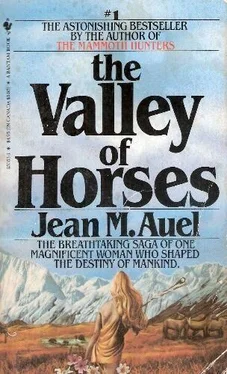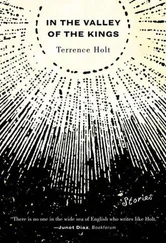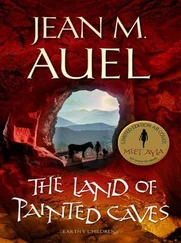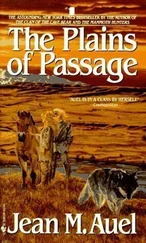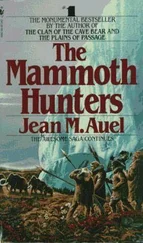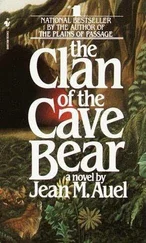But she couldn't rest long. Shivering violently in the cold water, she made herself crawl onto the rocky spit. She fumbled with the knots in the vine, and, with that loosened, she hauled the bundle to the beach. The thong was even more difficult to untie with her trembling fingers.
Providence helped. The thong broke at a weak spot. She clawed the long leather strap away, pushed the basket aside, and crawled on the bearskin and wrapped it around her. By the time her shivering stopped, the young woman was asleep.
Ayla headed north and slightly west after her perilous river crossing. The summer days warmed as she searched the open steppeland for some sign of humanity. The herbal blossoms that had brightened the brief spring faded, and the grass neared waist high.
She added alfalfa and clover to her diet, and welcomed the starchy, slightly sweet groundnuts, finding the roots by tracing rambling surface vines. Milk-vetch pods were swelling with rows of oval green vegetables in addition to edible roots, and she had no trouble distinguishing between them and their poisonous cousins. When the season for the buds of day lilies passed, the roots were still tender. A few early-ripening varieties of low-crawling currents had begun to turn color, and there were always a few new leaves of pigweed, mustard, or nettles for greens.
Her sling did not lack for targets. Steppe pikes, souslik marmots, great jerboas, varying hares – gray brown now instead of winter white – and an occasional, omnivorous, mouse-hunting giant hamster abounded on the plains. Low-flying willow grouse and ptarmigan were a special treat, though Ayla could never eat ptarmigan without remembering that the fat birds with the feathered feet had always been Creb's favorite.
But those were only the smaller creatures feasting on the plain's summer bounty. She saw herds of deer – reindeer, red deer, and enormous antlered giant deer; compact steppe horses, asses, and onagers, which resembled both; huge bison or a family of saiga antelope occasionally crossed her path. The herd of reddish brown wild cattle, with bulls six feet at the withers, had spring calves nursing at the ample udders of cows. Ayla's mouth watered for the taste of milk-fed veal, but her sling was not an adequate weapon to hunt aurochs. She glimpsed migrating woolly mammoths, saw musk oxen in a phalanx with their young at their backs facing down a pack of wolves, and carefully avoided a family of evil-tempered woolly rhinoceroses. Broud's totem, she recalled, and suitable, too.
As she continued northward, the young woman began to notice a change in the terrain. It was becoming drier and more desolate. She had reached the ill-defined northern limit of the wet, snowy continental steppes. Beyond, all the way to the sheer walls of the immense northern glacier, lay the arid loess steppes, an environment that existed only when glaciers were on the land, during the Ice Age.
Glaciers, massive frozen sheets of ice that spanned the continent, mantled the Northern Hemisphere. Nearly a quarter of the earth's surface was buried under their unmeasurable crushing tons. The water locked within their confines caused the level of the oceans to drop, extending the coastlines and changing the shape of the land. No portion of the globe was exempt from their influence, rains flooded equatorial regions and deserts shrunk, but near the borders of the ice the effect was profound.
The vast ice field chilled the air above it, causing moisture in the atmosphere to condense and fall as snow. But nearer the center high pressure stabilized, creating extreme dry cold and pushing the snowfall out toward the edges. The huge glaciers grew at their margins; the ice was nearly uniform across its full sweeping dimensions, a sheet of ice more than a mile thick.
With most of the snow falling on the ice and nourishing the glacier, the land just south of it was dry – and frozen. The constant high pressure over the center caused an atmospheric chute funneling the cold dry air toward lower pressures; wind, blowing from the north, never stopped on the steppes. It only varied in intensity. Along the way it picked up rock that had been pulverized to flour at the shifting border of the grinding glacier. The airborne particles were sifted to a texture only slightly coarser than clay – loess – and deposited over hundreds of miles to depths of many feet, and became soil.
In winter, howling winds whipped the scant snowfall across the bleak frozen land. But the earth still spun on its tilted axis, and seasons still changed. Average yearly temperatures only a few degrees lower trigger the formation of a glacier; a few hot days have little effect if they don't alter the average.
In spring the meager snow that fell on the land melted, and the crust of the glacier warmed, seeping down and out across the steppes. The meltwater softened the soil enough, above the permafrost, for shallow rooting grasses and herbs to sprout. The grass grew rapidly, knowing in the heart of its seed that life would be short. By the middle of summer, it was dry standing hay, an entire continent of grassland, with scattered pockets of boreal forest and tundra nearer the oceans.
In the regions near the borders of the ice, where the snow cover was light, the grass supplied fodder the year around for uncountable millions of grazing and seed-eating animals who had adapted to the glacial cold – and to predators who can adapt to any climate that supports their prey. A mammoth could graze at the foot of a gleaming, blue-white wall of ice soaring a mile or more above it.
The seasonal streams and rivers fed by glacial melt cut through the deep loess, and often through the sedimentary rock to the crystalline granite platform underlying the continent. Steep ravines and river gorges were common in the open landscape, but rivers provided moisture and gorges shelter from the wind. Even in the arid loess steppes, green valleys existed.
The season warmed, and, as one day followed the next, Ayla grew tired of traveling, tired of the monotony of the steppes, tired of the unrelenting sun and incessant wind. Her skin roughened, cracked, and peeled. Her lips were chapped, her eyes sore, her throat always full of grit. She came across an occasional river valley, greener and more wooded than the steppes, but none tempted her to stay, and all were empty of human life.
Though skies were usually clear, her fruitless search cast a shadow of fear and worry. Winter always ruled the land. On the hottest day of summer, the harsh glacial cold was never far from thought. Food had to be stockpiled and protection found to survive the long bitter season. She had been wandering since early spring and was beginning to wonder if she were doomed to roam the steppes forever – or die after all.
She made a dry camp at the end of another day that was so like the days that had gone before it. She had made a kill, but her coal was dead, and wood was getting more scarce. She ate a few bites raw rather than bothering with a fire, but she had no appetite. She threw the marmot aside, although game seemed more scarce too – or she wasn't keeping as sharp an eye out for it. Gathering was more difficult as well. The ground was hard-packed and matted with old growth. And there was always the wind.
She slept poorly, troubled by bad dreams, and awoke unrested. She had nothing to eat; even her discarded marmot was gone. She took a drink – stale and flat – packed her carrying basket, and started north.
Around noon she found a streambed with a few drying pools of water, which tasted slightly acrid, but she filled her waterbag. She dug up some cattail roots; they were stringy and bland, but she chewed on them as she plodded. She didn't want to go on, but she didn't know what else to do. Dispirited and apathetic, she wasn't paying much attention to where she was going. She didn't notice the pride of cave lions basking in the afternoon sun until one roared a warning.
Читать дальше
